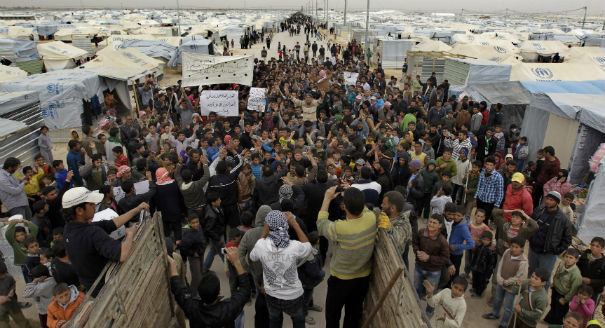Recent estimates place the total number of Syrian refugees in Jordan at over 500,000. Zaatari refugee camp has become the fourth largest city in Jordan by population—it may not be much of a home, but each refugee costs the Jordanian government 2,500 dinars ($3,750) to host per year. The cost of Syrian refugees is putting a tremendous strain on the economy and is affecting the patronage systems that have ensured tribal loyalty to Jordan’s monarchy in the past. In addition to increasing resentment within the tribal population, the presence of Syrian refugees has also provided a boost in support for the Muslim Brotherhood, Jordan’s best-organized opposition, thereby adding to the tension the Hashemite Kingdom faces.
Jordan’s ability to absorb Syrian refugees has become a growing issue. Its fiscal position has deteriorated since the beginning of the Arab Spring; hosting 500,000 refugees has already cost Jordan over $800 million since the Syrian war began, and unrest across the Arab world, particularly in neighboring Syria, has cost Jordan's economy as much as $4 billion. Furthermore, foreign assistance, on which Jordan was able to rely while dealing with the influx of Iraqi refugees, is insufficient. Prime Minister Abdullah Ensour recently stated in an interview that “the foreign assistance extended to Jordan is not enough in the face of the extraordinary numbers of Syrian refugees who have sought a safe haven in the Kingdom since the start of the Syrian conflict in March 2011.”
Government and UN officials say the refugee influx has placed a huge burden on already overstretched water and power supplies, as well as housing and education, which has rendered subsidy cuts necessary. The government has raised the prices of fuel and commercial electricity—and bread and water are expected to follow soon. Jordanians, reeling from these price increases, are also angry about the impact of the refugees on unemployment. According to the Ministry of Labor, approximately 160,000 Syrians work illegally in Jordan. They accept lower pay and tougher work conditions to fill positions in bakeries, garages, and cafes. This increases resentment amongst Jordanians, who suffer from an unemployment rate of 12.6 percent. It also feeds the attitude that “there is no room in Jordan for Jordanians”—the country is also home to 1.8 million Palestinian and 450,000 Iraqi refugees1. Unlike their Palestinian and Iraqi predecessors, however, the majority of Syrians arrive with limited funds, placing an immediate burden on Jordan’s social services.
Bedouin tribes and townships have expressed growing anger at the failure of the government to do more to help the areas that have borne the biggest burden from the refugees. Tribes are protesting against the loss of their traditional economic privileges from a nation on an enormous fiscal deficit. Should the economic strain brought on by the Syrian refugees continue, significant divisions are likely to develop between the monarchy and its institutions in the future: tribal benefactors are the backbone of support for the monarchy, and their traditional economic privileges will likely continue to be reduced to meet the demands of the fiscal deficit. This would give renewed impetus to the street demonstrations (known as hirak) and would fuel protests by public sector workers and army veterans at a time when the Palace has done little to meet popular demands on disengagement, corruption, or economic restructuring. Moreover, it is possible that as Syrian refugees become increasingly desperate and politicized, these economic problems could mutate into political tension. In response, the government has reportedly denied entry to Syrians of Palestinian origin, fearing it may upset Jordan’s delicate political balance, although the government denies this. Memories of the 1970 Black September civil war between the Jordanian government and militias made up of Palestinian refugees make authorities wary of any political activity among the Syrian refugees.
Furthermore, Syrian refugees are finding resonance and appeal within Jordan’s Muslim Brotherhood and its political wing, the Islamic Action Front (IAF). The Syrian refugee population is used to bolster local perceptions of the movement’s political strength: many who joined the movement on the street during protests over the last few months were, in fact, members of the Syrian Muslim Brotherhood. Although the increase in their numbers does not translate into electoral success, it allows them to demonstrate their informal power during weekly Friday protests. And while the IAF has remained loyal to the monarchy and continues to work within the confines of the established political order, its leaders have shown an increasing readiness to challenge royal authority in recent months. Furthermore, as the Syrian Muslim Brotherhood opposition flocks to Jordan, it highlights an additional challenge for Jordan’s King Abdullah II, who—while calling for Assad to step down—maintains hopes for a secular order in a new Syria and has long been wary of how the conflict might increase the clout of Jordan’s own Muslim Brotherhood.
As the Syrian refugees increasingly strain the Jordanian economy, the old patronage systems that ensured tribal loyalty to Jordan’s monarchy in the past are negatively affected. And while Syrian refugees increase their support for the Muslim Brotherhood, the Hashemite monarchy is responding by strengthening their backing for Western efforts to replace the Brotherhood-dominated Syrian National Council with a varied opposition, one that is inclusive of Alawites and other minorities. This secularism would be necessary to dilute the effects of a more powerful Muslim Brotherhood next door and maintain the much-needed secular balance within the Hashemite Kingdom. The monarchy now faces the difficult task of bolstering its support from its domestic population while negating the effects of religious politicization.
Nikita Malik is a PhD candidate at the University of Cambridge studying Middle Eastern politics. She is conducting field research in Amman, Jordan.
1. The figures used are provided by UNRWA and rely on the UN's definition of registered refugees.↩






